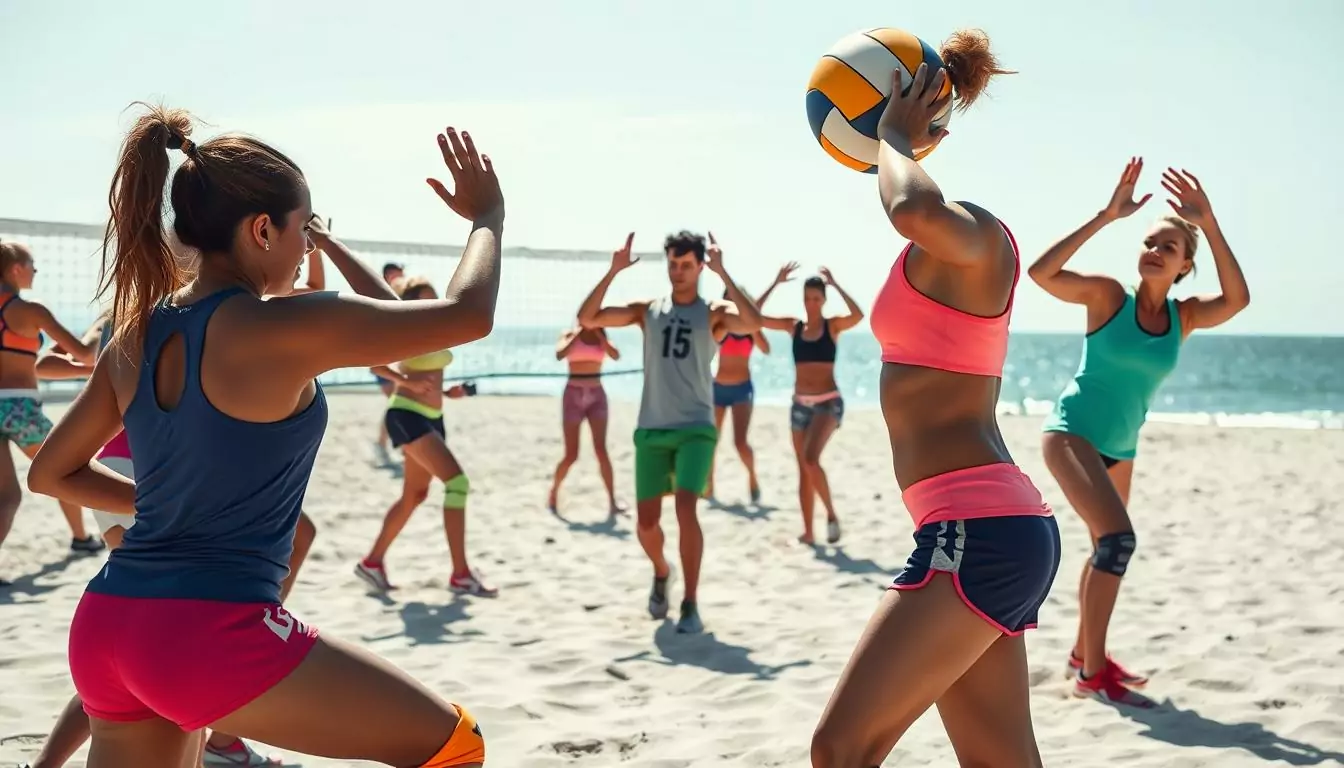In 2015, the U.S. Consumer Product Safety Commission reported over 183,000 volleyball-related injuries. Volleyball is a small part of organized sports injuries, but it’s growing. This means more injuries could happen.
Common injuries in volleyball include shoulder problems, ankle sprains, and finger injuries. Despite this, volleyball is safer than many other team sports. Indoor volleyball has an injury rate of 2.6 injuries/1000 hours. Beach volleyball might even be safer.
Key Takeaways
- Volleyball injuries are on the rise due to increasing participation, but the overall injury rate remains relatively low compared to other sports.
- Common volleyball injuries include overuse shoulder issues, ankle sprains, and finger injuries.
- Proper injury prevention strategies, including strength training, flexibility, warm-ups, and technique development, can help reduce the risk of injuries.
- Hydration, sun protection, and court maintenance are also important for player safety.
- Coaches and parents play a critical role in promoting injury prevention and safe playing environments.
Understanding Common Volleyball Injuries
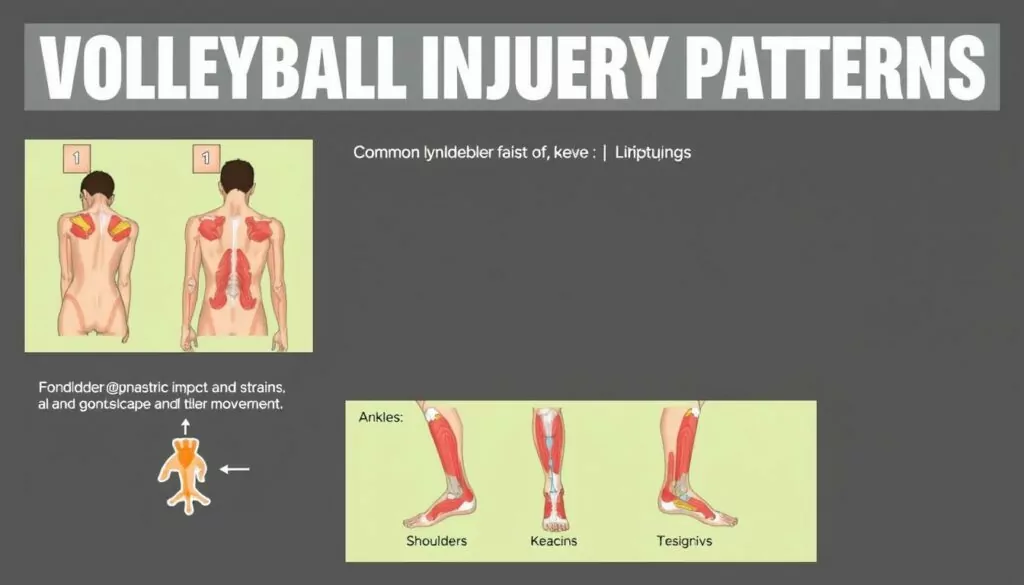
As a passionate volleyball player, I’ve learned about the injuries we face. From ankle sprains to jumper’s knee, knowing the risks helps us stay safe.
Types of Injuries in Volleyball
Ankle injuries are the most common, making up half of all volleyball injuries. They can be mild sprains or severe tears. Knee problems, like jumper’s knee, are also common due to the game’s jumping and landing.
Shoulder injuries, such as impingement and instability, are common too. Setters and defensive players often get finger jams from the net. Lower back pain also happens from the twisting and bending in volleyball.
Symptoms and Signs to Watch For
Symptoms vary by injury type and severity. Look out for pain, swelling, limited movement, and weakness. Acute injuries, like ankle sprains, hurt right away. Overuse injuries, like jumper’s knee, develop over time.
Recovery Time Frames for Injuries
Recovery times differ for each injury. Ankle sprains take about 4.5 weeks to heal. Knee injuries, like jumper’s knee, can take weeks to months. Shoulder injuries also need time, often with physical therapy.
Working with sports medicine specialists and physical therapists is key. They help with diagnosis and treatment for a full recovery.
| Injury Type | Percentage of Volleyball Injuries | Average Recovery Time |
|---|---|---|
| Ankle Sprains | 75% | 4.5 weeks |
| Knee Injuries (Patellar Tendinitis) | 30% | 2-6 months |
| Shoulder Overuse Injuries | 57% | 6-12 weeks |
| Finger Jams | 15% | 2-4 weeks |
| Lower Back Pain | 20% | 4-8 weeks |
Importance of Injury Prevention
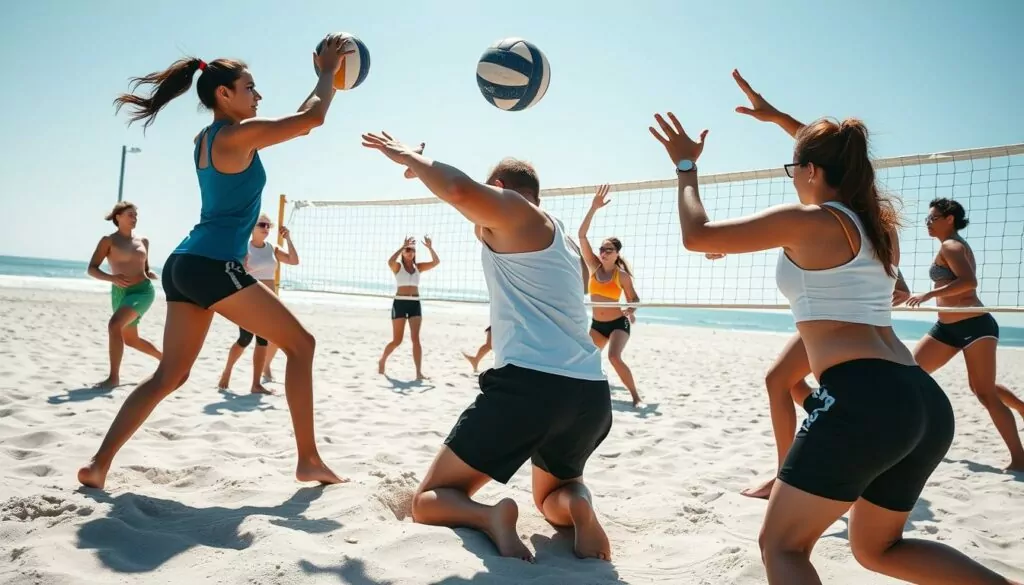
As a volleyball player, I know how vital injury prevention is. Keeping my performance and health in top shape is my main goal. Preventing injuries helps me do just that.
Injuries can really set me back, keeping me out of training and games for a long time. Ankle sprains, rotator cuff tendinitis, finger fractures, and jumper’s knee are common. Ignoring prevention can lead to missing out on the sport and harm my health long-term.
The Impact of Injuries on Performance
Being out due to an injury affects my performance a lot. Missing practices and games means I lose time to improve and stay in shape. This makes it hard to get back to my best when I return.
Long-term Health Benefits
Preventing injuries also protects my long-term health. Repeated injuries can cause chronic problems and increase the risk of osteoarthritis. By focusing on prevention, I’m looking out for my future health and enjoying volleyball for years.
“Injury prevention is not just about staying on the court today; it’s about protecting your long-term physical health and well-being.”
Injury prevention is key for keeping my performance up and avoiding long-term health issues. By understanding common injuries and using prevention strategies, I can stay active and keep improving.
Strength Training for Volleyball Players
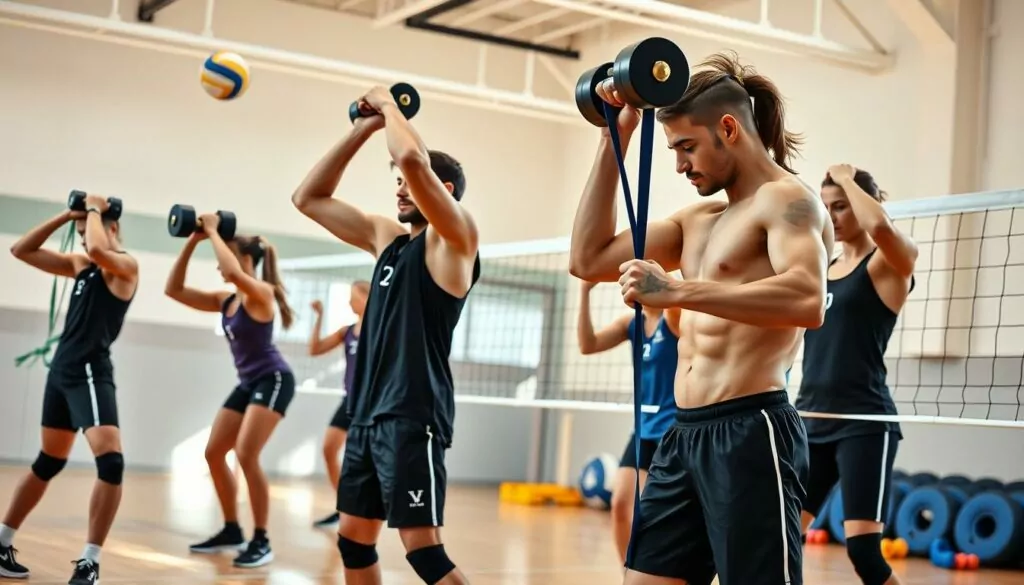
As a volleyball player, adding strength training to your routine is key. It helps prevent injuries and boosts your performance. By focusing on important muscle groups and following a balanced workout plan, you can reach your full volleyball ability.
Key Muscle Groups to Target
Volleyball needs explosive power, agility, and stability. To meet these needs, it’s important to strengthen certain muscle groups:
- Shoulders: For serving, passing, and blocking
- Core: For stabilization and power transfer
- Lower Body: For jumping, lateral movement, and landing
Recommended Strength Exercises
Here are some exercises to target these muscle groups:
- Good Mornings: 3 sets of 10-15 reps
- Single Leg RDL to Overhead Press: 3 sets of 8-12 reps per side
- Lateral Lunge with a Press: 3 sets of 10-15 reps per side
- Dumbbell Squat to Press: 3 sets of 12-20 reps
These exercises help improve your strength, power, and stability. They reduce injury risk and boost your volleyball skills.
Creating a Balanced Workout Routine
For the best results, create a well-rounded strength training program. Include resistance training, plyometrics, and core stability exercises. This covers all aspects of volleyball fitness.
Always listen to your body and increase intensity slowly. Make sure to train smartly to avoid injuries. With consistent effort, you’ll gain the strength needed to excel in volleyball.
Flexibility and Stretching Techniques
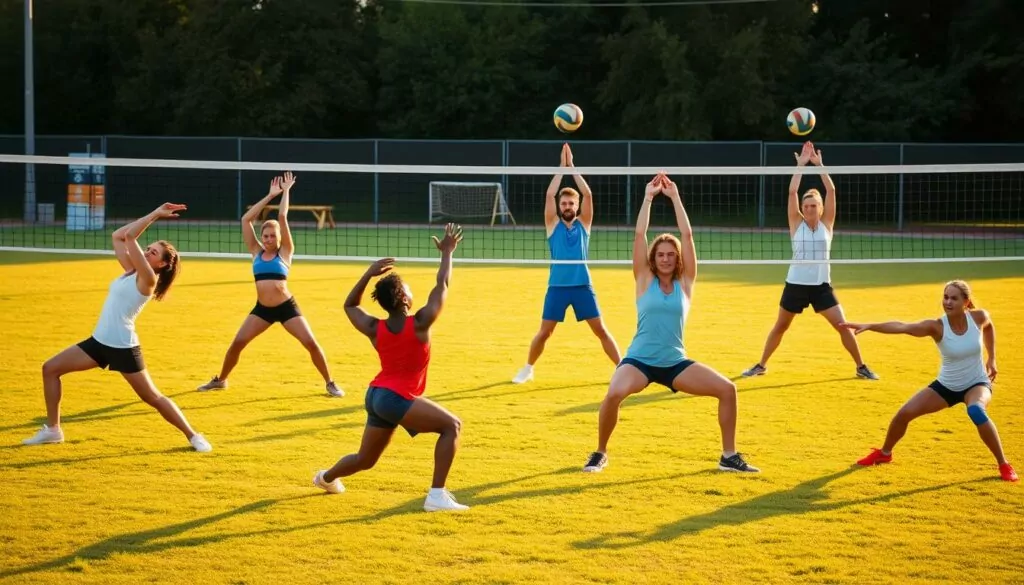
As a volleyball player, I know how important flexibility and stretching are. Cold muscles are more likely to get hurt. So, it’s key to warm up and stretch before playing or practicing.
I start with 3-5 minutes of light exercise. Then, I do slow stretches for 30 seconds each.
Importance of Stretching Before Games
Volleyball is tough on our muscles and joints. Without proper preparation, we risk strains and sprains. I always stretch before games to stay flexible and prevent injuries.
Stretching helps me move better and keeps my body ready for action.
Effective Stretching Routines
- Dynamic stretches for the shoulders, hips, and legs to increase blood flow and mobility
- Static stretches to lengthen muscle groups like the quadriceps, hamstrings, and calves
- Foam rolling or massage to release tension in tight muscles
- Targeted stretches for common problem areas like the lower back and Achilles tendon
Tools to Aid Flexibility
I use tools like resistance bands and exercise balls to stretch better. Yoga blocks help me reach deeper stretches. Regular yoga has also boosted my flexibility and injury prevention.
“Proper stretching and flexibility training is one of the most important factors in preventing volleyball injuries. It’s vital to make time for it before and after every practice or match.”
By focusing on volleyball stretching techniques, flexibility, and injury prevention, I play my best while avoiding injuries. It’s a key part of my training.
Proper Warm-up Strategies
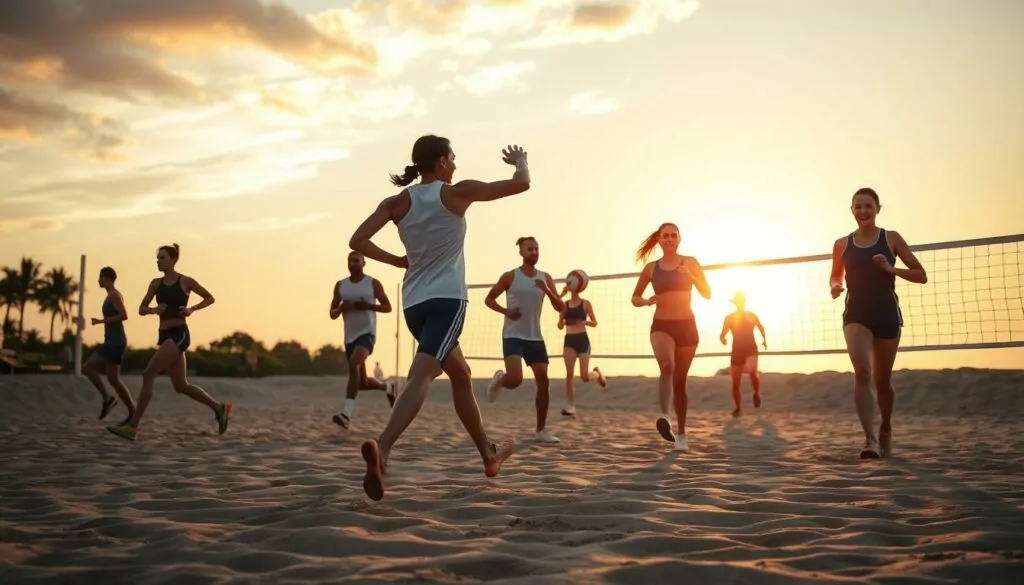
As a volleyball player, I know how key a good warm-up is. It gets my body ready for the game’s physical challenges. This is vital for top performance and avoiding injuries. So, I always include a detailed warm-up in my pre-game routine.
My Pre-game Warm-up Rituals
I begin with a light jog for 5-10 minutes. This gets my heart rate up and warms my muscles. Then, I do dynamic stretches like leg swings and lunges to boost my flexibility and movement.
I also add plyometric exercises like jump squats. These help me jump higher and move faster.
Dynamic vs. Static Warm-ups
Dynamic warm-ups are better for getting ready for volleyball than static stretches. They activate the muscles I’ll use during the game. Static stretches, on the other hand, can lower my power and increase injury risk if done before intense activity.
Tips for Effective Warm-up Sessions
- Incorporate ball handling drills, such as passing and setting, to warm up my muscles and improve my skills.
- Focus on core stability exercises to enhance my balance and reduce the risk of lower back injuries.
- Use plyometric exercises to develop explosive power and agility, which are critical for volleyball.
- Listen to my body and adjust the intensity of the warm-up based on how I’m feeling on a given day.
By using these volleyball warm-up and pre-game rituals, I prepare my body well for the game. This helps me stay healthy and perform at my best. A good warm-up is key to my success on the court.
Cool Down Essentials
Cooling down after a tough volleyball game is key to avoiding injuries and recovering well. As a serious volleyball player, I always make sure to cool down. This step is vital for reducing muscle soreness and keeping my body flexible.
Why I Never Skip Cooling Down
Studies show that cold muscles are more injury-prone. So, it’s important to slowly bring my heart rate and body temperature back down. This helps clear out lactic acid, aids in recovery, and gets me ready for the next game or practice.
Effective Cool Down Techniques
- Light aerobic activity, such as walking or slow jogging, for about 5-10 minutes
- Dynamic stretching to target the major muscle groups used in volleyball
- Static stretching, holding each stretch for 30 seconds or more
- Foam rolling or using a massage ball to release muscle tension
Monitoring My Body Post-Game
After a game, I always check how my body is feeling. I look for any pain, swelling, or discomfort. I also watch my energy levels and overall recovery. This helps me catch any issues early and prevent them from getting worse.
| Injury | Prevalence in Volleyball | Importance of Cool Down |
|---|---|---|
| Ankle Sprains | Highly Common | Helps maintain flexibility and range of motion in the ankle |
| Knee Injuries | Frequent | Reduces stress on the knees and aids in recovery |
| Shoulder Injuries | Prevalent | Promotes blood flow and flexibility in the shoulder joint |
| Finger Injuries | Common in Beach Volleyball | Helps maintain dexterity and range of motion in the fingers |
By making cool-down a priority after every game, I’m protecting my body and keeping it ready for the next match. It’s a simple yet powerful way to safeguard my health and keep loving the sport.
Technique and Skill Development
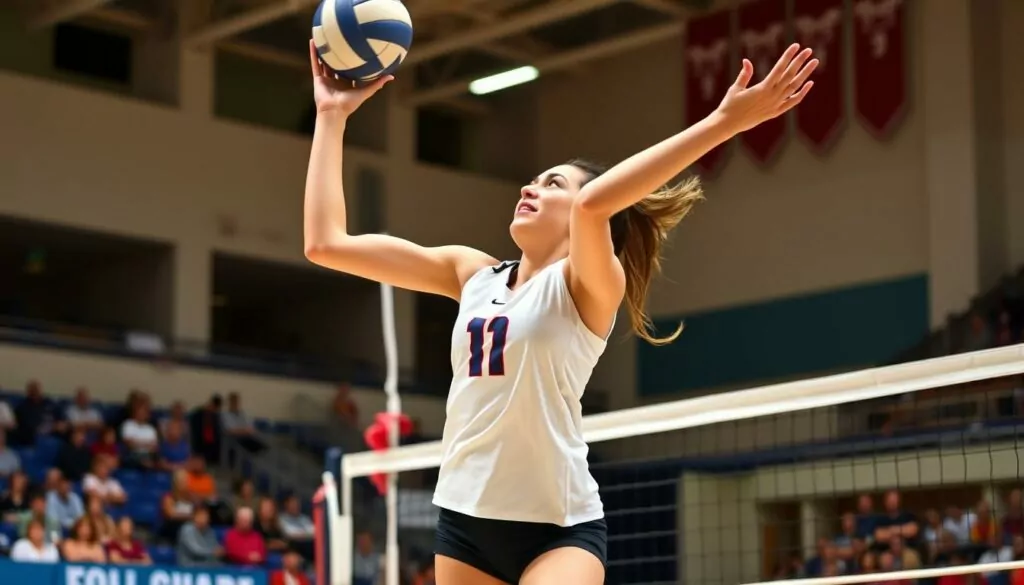
As a volleyball fan, I’ve learned how key proper technique is in avoiding injuries. The way we do skills like spiking, blocking, and setting affects our injury risk. By focusing on the right form, we boost our game and protect our bodies.
Role of Technique in Injury Prevention
Bad technique can cause muscle strains and joint problems, keeping us off the court for a long time. It’s vital to work on our volleyball skills with a focus on technique. Learning the right form for each skill helps reduce muscle and joint stress, lowering injury chances.
Drills to Improve Volleyball Skills
- Do drills that focus on body alignment and movement, like:
- Setting drills that work on hand position and wrist flexibility
- Spiking drills that improve arm swing and shoulder mechanics
- Blocking drills that teach correct jump technique and timing
- Add plyometric exercises to build explosive power and agility while keeping form right
- Practice footwork drills to better cover the court and stay balanced
Seeking Professional Coaching
While practicing alone is important, a good volleyball coach offers great help. They can spot areas to improve, give feedback on form, and create training plans that focus on both skill and safety.
“Proper volleyball technique is not only a performance enhancer but also a key injury prevention strategy. By mastering the basics, we can lower injury risk and enjoy the game for years.”
Importance of Footwear
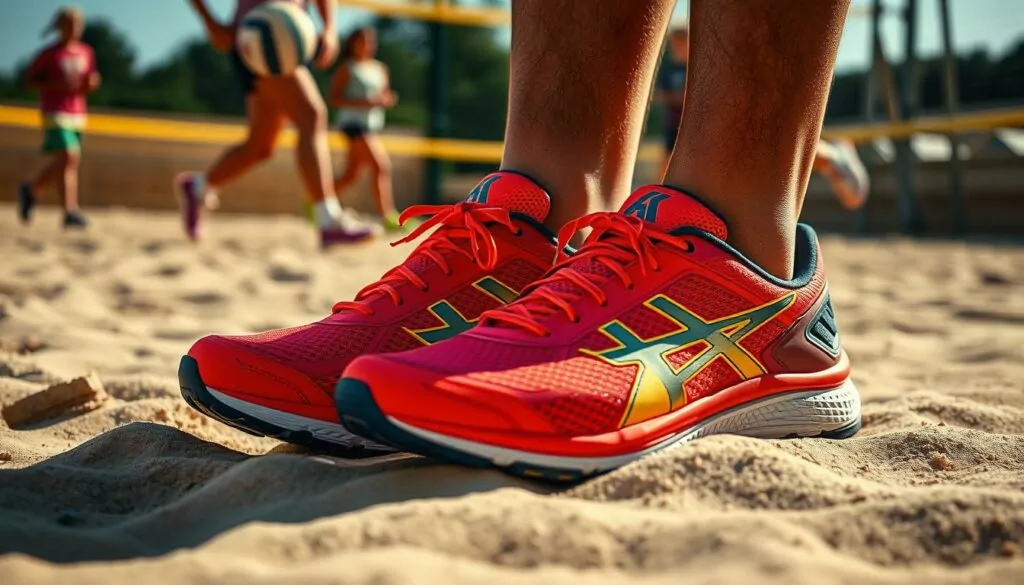
As a volleyball player, I know how key the right shoes are. They help prevent injuries and boost my performance. The right shoes make me feel comfortable, stable, and safe on the court.
Choosing the Right Volleyball Shoes
When picking volleyball footwear, I look for support and shock absorption. These are key to avoiding injuries like ankle sprains and knee pain.
How Shoes Affect Performance and Comfort
The shoe selection greatly affects my performance and comfort. Good shoes let me move fast, jump high, and stay stable. Bad shoes can cause fatigue, muscle strain, and poor coordination.
Tips for Maintaining My Volleyball Gear
- Regularly clean and check my volleyball gear, including shoes, to keep them in top shape.
- Swap out worn-out or damaged shoes to keep my gear in good condition and protect myself.
- Properly store my volleyball shoes and equipment to make them last longer and avoid damage.
| Injury Type | Incidence Rate | Average Time Lost |
|---|---|---|
| Ankle Sprains | 1 per 1000 hours | 4.5 weeks |
| Patellar Tendinitis | Common Knee Injury | Variable |
| ACL Tears | Prevalent Knee Injury | Varies |
| Rotator Cuff Tendinitis | Common Shoulder Injury | Depends on Severity |
| Finger Injuries | 17% of Acute Injuries | Depends on Injury Type |
“Proper footwear is key to preventing injuries in volleyball. Shoes should offer strong ankle and arch support, and good shock absorption.”
By choosing the right volleyball footwear and keeping my gear in check, I can lower injury risks and play my best. Making sure I have the right shoes and maintain my gear is a big part of staying safe and performing well.
Nutrition for Injury Prevention

As a volleyball player, eating right is key to avoiding injuries. Drinking enough water is essential for staying at the top of your game. I drink 24 ounces of water 2 hours before I exercise and 8 ounces right before. During games, I drink water every 20 minutes to stay hydrated.
My Go-to Snacks for Energy
To keep my energy up, I eat balanced snacks. Some of my favorites are:
- Whole grain crackers with peanut butter
- Greek yogurt with fresh berries
- Trail mix with nuts, seeds, and dried fruit
- Sliced apples or bananas with almond butter
These snacks give me the energy I need to perform well on the court.
Importance of Hydration
Drinking enough water is vital for volleyball players. Dehydration can cause muscle cramps, fatigue, and increase injury risk. I drink lots of water all day, and I’m careful with my hydration before, during, and after games.
Supplements and Their Role in Recovery
I also use supplements to help with recovery and injury prevention. I take a daily multivitamin to get all the nutrients I need. Omega-3 fatty acids help reduce inflammation and aid in muscle recovery. But, I always talk to a sports nutritionist to make sure I’m using the right supplements for me.
“Proper nutrition supports the body by providing essential nutrients for muscle repair, bone strength, and overall fitness, contributing significantly to athletic performance and injury prevention.”
Listening to My Body

As a volleyball player, it’s key to listen to my body. This helps prevent injuries. By body awareness, I catch early signs of fatigue and avoid injuries. I notice when I’m not performing well or feeling pain.
Recognizing Signs of Fatigue
Fatigue can lead to injuries in volleyball. I watch for signs like decreased power and muscle soreness. These signs tell me when to rest and recover.
- Decreased power and accuracy in my shots
- Increased muscle soreness or joint pain
- Reduced agility and reaction time
- Difficulty maintaining proper form and technique
Knowing When to Rest
Knowing when to rest is vital for injury prevention. I take regular breaks and listen to my body. This keeps me strong and injury-free.
Strategies for Mental Resilience
Mental toughness is as important as physical strength. I use mindfulness to handle stress and anxiety. This helps me stay focused and resilient.
“Listening to your body is the first step towards injury prevention. It’s not just about physical preparation, but also about mental resilience and being in tune with your own needs.”
Safety Practices During Play
Keeping the volleyball court safe is key to avoiding injuries and keeping the game fun. As a serious volleyball player, I know how important it is to follow safety rules and talk well with my teammates.
Understanding Court Safety Rules
The volleyball court must be safe for everyone. Important safety rules include:
- Maintaining a minimum overhead clearance of 23 feet to prevent collisions with ceiling or other structures.
- Covering any support wires for the volleyball net with soft, protective material to minimize the risk of impact injuries.
- Regularly inspecting the playing surface for any hazards, like cracks or uneven floors, and fixing them before play starts.
The Importance of Communication With Teammates
Talking clearly with my teammates is vital for a safe and winning game. By shouting when I’m going for the ball, I can avoid crashes and injuries. Knowing where my teammates are and what they might do helps me move fast and stay safe.
Playing in Safe Environments
It’s not just the court that needs to be safe. Before each game, I check the area around the court for dangers, like loose stuff or uneven ground. This way, I can play without worrying about unexpected dangers.
| Injury Statistic | Percentage/Rate |
|---|---|
| Concussions make up more than 15% of all volleyball injuries. | 15% |
| Around 35% of injuries cause players to miss three to six days of participation. | 35% |
| Approximately 12.1% of injuries are severe, leading to 21 or more days of time loss. | 12.1% |
| On average, for every 1,000 hours of volleyball played, expect 1.5 to 2 injuries. | 1.5 to 2 injuries per 1,000 hours |
| During match play, the estimated number of injuries rises to 2-4 per 1,000 hours. | 2-4 injuries per 1,000 hours |
By focusing on safety during play, I help make volleyball safe and fun for everyone. Following safety rules, talking well, and playing in safe places lets me enjoy the game without worrying about injuries.
Injury Assessment and Treatment
As a volleyball player, I know how vital proper injury care is. If I get hurt, I seek medical help right away. Coaches can handle minor injuries, but for serious ones, getting to a doctor is key.
Seeking Medical Attention When Necessary
Injuries can be anything from small sprains to serious problems. I always see a sports medicine expert or athletic trainer for ongoing pain. They check me out and tell me what to do next.
Common Treatment Options
- Rest, ice, compression, and elevation (RICE) for acute injuries
- Physical therapy and rehabilitation exercises to address muscle imbalances and restore range of motion
- Bracing or taping to provide support and stabilization
- Anti-inflammatory medications to reduce swelling and pain
- In some cases, surgical intervention may be necessary for severe injuries
When to Return to Play
Deciding when to go back to volleyball after an injury is big. I only play again when I’m fully healed and have no pain. Getting the okay from a doctor is also a must.
By focusing on injury care, I can avoid more problems and keep playing well. Being proactive about my health is part of my dedication to volleyball.
Engaging in Cross-Training
As a passionate volleyball player, I’ve found that cross-training is key to staying injury-free. Doing different physical activities helps improve my fitness and lowers the chance of injuries. These are common in athletes who only play one sport.
Benefits of Diverse Physical Activities
Adding various exercises to my routine helps me work different muscles. This boosts my strength, flexibility, and coordination. It also makes me a better volleyball player and less likely to get hurt.
Recommended Cross-Training Exercises
- Swimming: Low-impact and works the entire body, great for active recovery.
- Cycling: Improves leg strength and endurance without high-impact stress on the joints.
- Yoga: Enhances flexibility, balance, and core stability.
- Strength training: Builds muscle strength and supports injury prevention.
- Plyometrics: Improves explosive power and agility, key for volleyball.
Balancing Volleyball with Other Sports
As a young athlete, I’ve learned it’s bad to play one sport all year. Doing different diverse physical activities helps me stay skilled, keeps me excited about the game, and prevents long-term injuries.
My cross-training keeps me healthy and lets me play at my best. It’s a smart way to enjoy volleyball for many years. By choosing injury prevention through various activities, I’m setting myself up for success.
Psychological Aspects of Injury Recovery
As a volleyball player, I’ve learned that the mind plays a big role in getting better after an injury. Keeping a positive outlook and using mental tricks are key. Having a strong support network also helps a lot.
Staying Positive Through Recovery
It’s normal to feel down and upset when you’re recovering. But, staying positive can really help. I use things like visualization, affirmations, and setting goals to stay focused and driven. I tell myself that my injury is just temporary and I can get through it.
Techniques for Mental Preparation
- Visualization: I imagine myself doing well in volleyball drills and games, seeing myself fully recover.
- Positive self-talk: I say positive things to myself to boost my confidence and fight off negative thoughts.
- Goal setting: I set achievable goals for my recovery to see how far I’ve come.
Building a Support Network
Having a strong support network has been really important during my volleyball injury recovery. My coaches, teammates, and doctors have all been super helpful. My family and friends have also been there for me, helping me deal with the emotional side of healing.
| Injury Statistic | Value |
|---|---|
| Reported Injuries in Male Volleyball Players | 43.93% |
| Median Pain Intensity for Injured Players | 3 (on a scale of 1-10) |
| Median Psychological Readiness to Return to Sport Score | 54 (out of 100) |
| Correlation Between Pain and Psychological Readiness | Inverse and moderate (rs = -0.36) |
By focusing on the psychological aspects of injury recovery, I’ve been able to get through it with more strength and determination. With the right mindset and a supportive group, I’m ready to come back to the sport I love.
Staying Informed on Volleyball Trends
I love playing volleyball and keeping up with the latest research and trends is key. It helps me stay safe and play my best. By following volleyball news, I learn new strategies and techniques to prevent injuries.
Following the Latest Research on Injuries
Studies have shown common volleyball injuries like ankle sprains and shoulder problems. The NCAA, High School Reporting Information Online, and FIVB Injury Surveillance System have shared this data. Knowing this helps me prevent injuries by understanding the risks.
Engaging with the Volleyball Community
Online forums, social media, and local events are great for volleyball fans. Sharing tips and experiences helps us all learn and grow. It also builds a sense of community and encourages us to focus on injury prevention.
Attending Workshops and Clinics
Workshops and clinics teach us about injury prevention and improving performance. They offer expert advice and hands-on training. This knowledge helps me protect my volleyball career and stay injury-free.
Keeping up with volleyball trends is essential for injury prevention. By using these resources, I make smart choices and stay safe. This way, I can enjoy a long and successful volleyball career without worrying about injuries.
| Injury Statistic | Value |
|---|---|
| Injury incidence in elite indoor volleyball players | 0.53-0.94 injuries per player |
| Injury incidence in national volleyball teams | 2.6 per 1000 hours of play |
| Injury incidence in professional volleyball | 10.7 per 1000 player hours |
| Injury rates in collegiate women’s volleyball | 3.81-6.73 per 1000 athlete exposures |
| High school volleyball players in 2021-2022 | 520.6 thousand |
| Economic cost of injuries in the US | $4.2 trillion, with $327 billion in medical care |
| Return to pre-injury performance after ACL surgery | Less than 50% |
| Volleyball-related injuries among adolescents (2013-2022) | 347,395 |
The table shows how big of a problem volleyball injuries are. By staying informed, I can protect my health and play better.
“Staying informed on the latest volleyball injury research and engaging with the community has been a game-changer for my approach to injury prevention. The insights I’ve gained have empowered me to take proactive steps to safeguard my health and pursue a long, successful volleyball career.”
Final Thoughts on Injury Prevention
Injury prevention in volleyball is a big job that needs a strong commitment to safety. As a serious volleyball player, I know how key it is to have a solid injury prevention plan. By focusing on team safety and making a personal plan, we can lower injury risks and play longer.
My Commitment to Staying Injury-Free
Keeping my volleyball career healthy and injury-free is my main goal. I promise to follow the best practices from this guide, like doing proper warm-ups and strength training. By taking care of my body, I’m sure I can play at my best and avoid serious injuries.
Emphasizing Team Support for Safety
Building a team culture that values injury prevention is vital. I’ll team up with my teammates and coaches to stress the need for safety and open talk. Together, we can make a safer environment and support each other’s success.
Creating a Personal Injury Prevention Plan
It’s important to have a personal injury prevention plan that fits my needs and position. I’ll check my physical health, review my training and games, and work with health experts to improve my plan. By using proven strategies, I can stay safe and perform at my best.
